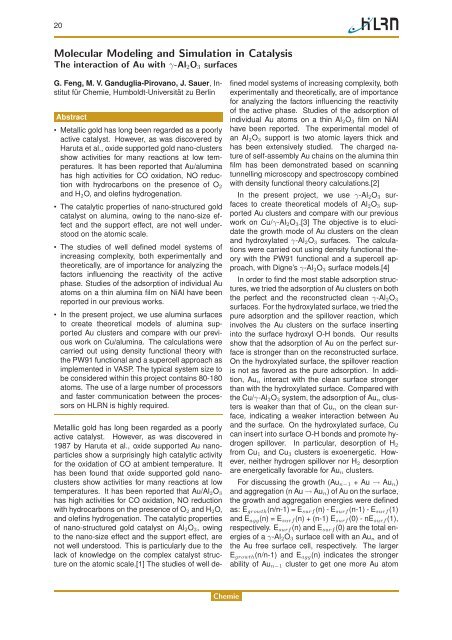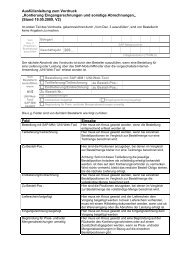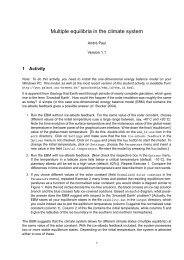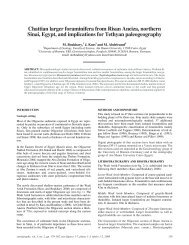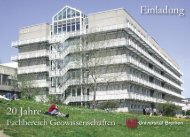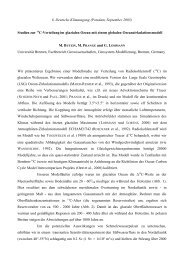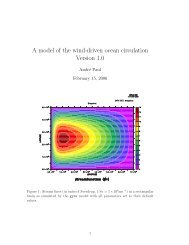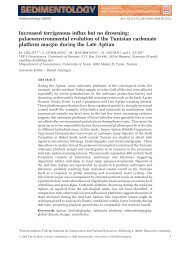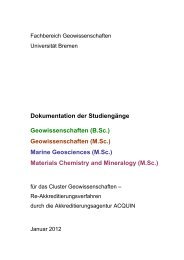Forschung im HLRN-Verbund 2011
Forschung im HLRN-Verbund 2011
Forschung im HLRN-Verbund 2011
- Keine Tags gefunden...
Erfolgreiche ePaper selbst erstellen
Machen Sie aus Ihren PDF Publikationen ein blätterbares Flipbook mit unserer einzigartigen Google optimierten e-Paper Software.
20Molecular Modeling and S<strong>im</strong>ulation in CatalysisThe interaction of Au with γ-Al 2 O 3 surfacesG. Feng, M. V. Ganduglia-Pirovano, J. Sauer, Institutfür Chemie, Humboldt-Universität zu BerlinAbstract• Metallic gold has long been regarded as a poorlyactive catalyst. However, as was discovered byHaruta et al., oxide supported gold nano-clustersshow activities for many reactions at low temperatures.It has been reported that Au/aluminahas high activities for CO oxidation, NO reductionwith hydrocarbons on the presence of O 2and H 2 O, and olefins hydrogenation.• The catalytic properties of nano-structured goldcatalyst on alumina, owing to the nano-size effectand the support effect, are not well understoodon the atomic scale.• The studies of well defined model systems ofincreasing complexity, both exper<strong>im</strong>entally andtheoretically, are of <strong>im</strong>portance for analyzing thefactors influencing the reactivity of the activephase. Studies of the adsorption of individual Auatoms on a thin alumina film on NiAl have beenreported in our previous works.• In the present project, we use alumina surfacesto create theoretical models of alumina supportedAu clusters and compare with our previouswork on Cu/alumina. The calculations werecarried out using density functional theory withthe PW91 functional and a supercell approach as<strong>im</strong>plemented in VASP. The typical system size tobe considered within this project contains 80-180atoms. The use of a large number of processorsand faster communication between the processorson <strong>HLRN</strong> is highly required.Metallic gold has long been regarded as a poorlyactive catalyst. However, as was discovered in1987 by Haruta et al., oxide supported Au nanoparticlesshow a surprisingly high catalytic activityfor the oxidation of CO at ambient temperature. Ithas been found that oxide supported gold nanoclustersshow activities for many reactions at lowtemperatures. It has been reported that Au/Al 2 O 3has high activities for CO oxidation, NO reductionwith hydrocarbons on the presence of O 2 and H 2 O,and olefins hydrogenation. The catalytic propertiesof nano-structured gold catalyst on Al 2 O 3 , owingto the nano-size effect and the support effect, arenot well understood. This is particularly due to thelack of knowledge on the complex catalyst structureon the atomic scale.[1] The studies of well definedmodel systems of increasing complexity, bothexper<strong>im</strong>entally and theoretically, are of <strong>im</strong>portancefor analyzing the factors influencing the reactivityof the active phase. Studies of the adsorption ofindividual Au atoms on a thin Al 2 O 3 film on NiAlhave been reported. The exper<strong>im</strong>ental model ofan Al 2 O 3 support is two atomic layers thick andhas been extensively studied. The charged natureof self-assembly Au chains on the alumina thinfilm has been demonstrated based on scanningtunnelling microscopy and spectroscopy combinedwith density functional theory calculations.[2]In the present project, we use γ-Al 2 O 3 surfacesto create theoretical models of Al 2 O 3 supportedAu clusters and compare with our previouswork on Cu/γ-Al 2 O 3 .[3] The objective is to elucidatethe growth mode of Au clusters on the cleanand hydroxylated γ-Al 2 O 3 surfaces. The calculationswere carried out using density functional theorywith the PW91 functional and a supercell approach,with Digne’s γ-Al 2 O 3 surface models.[4]In order to find the most stable adsorption structures,we tried the adsorption of Au clusters on boththe perfect and the reconstructed clean γ-Al 2 O 3surfaces. For the hydroxylated surface, we tried thepure adsorption and the spillover reaction, whichinvolves the Au clusters on the surface insertinginto the surface hydroxyl O-H bonds. Our resultsshow that the adsorption of Au on the perfect surfaceis stronger than on the reconstructed surface.On the hydroxylated surface, the spillover reactionis not as favored as the pure adsorption. In addition,Au n interact with the clean surface strongerthan with the hydroxylated surface. Compared withthe Cu/γ-Al 2 O 3 system, the adsorption of Au n clustersis weaker than that of Cu n on the clean surface,indicating a weaker interaction between Auand the surface. On the hydroxylated surface, Cucan insert into surface O-H bonds and promote hydrogenspillover. In particular, desorption of H 2from Cu 1 and Cu 3 clusters is exoenergetic. However,neither hydrogen spillover nor H 2 desorptionare energetically favorable for Au n clusters.For discussing the growth (Au n−1 + Au → Au n )and aggregation (n Au → Au n ) of Au on the surface,the growth and aggregation energies were definedas: E growth (n/n-1) = E surf (n) - E surf (n-1) - E surf (1)and E agg (n) = E surf (n) + (n-1) E surf (0) - nE surf (1),respectively. E surf (n) and E surf (0) are the total energiesof a γ-Al 2 O 3 surface cell with an Au n and ofthe Au free surface cell, respectively. The largerE growth (n/n-1) and E agg (n) indicates the strongerability of Au n−1 cluster to get one more Au atomChemie


